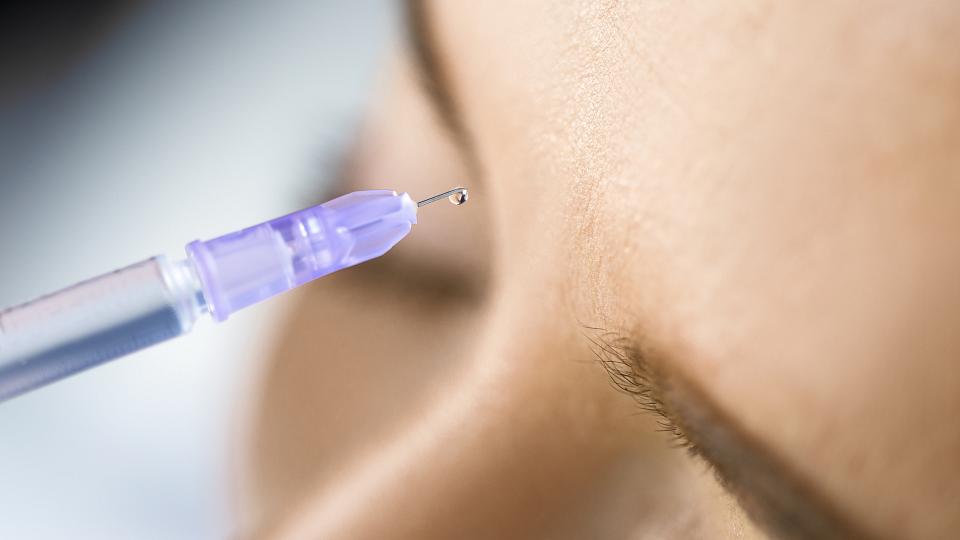
The Basics of Botox: What to Know Before Your First Shot
While the word “Botox” is often used as a blanket term to describe a cosmetic procedure, it is actually a brand name that has become synonymous with the process. So, what exactly is Botox?
Botox is an injectable medication that smooths out wrinkles and frown lines by preventing muscle contractions. The injection contains a toxin from the bacterium clostridium botulinum that temporarily blocks the nerve signals that cause the facial muscles to contract.
“It essentially turns off the signal to the muscle from the nerve, and selectively relaxes the muscle for an average of three months,” says Sarah R. Akkina, MD, MSC, an assistant professor and director of Facial Plastic and Reconstructive Surgery in the Department of Otolaryngology – Head & Neck Surgery at University of Utah Health.
Why Get Botox?
Many people start getting Botox in their mid to late 30s to reduce the appearance of facial wrinkles associated with aging, such as:
- Frown lines
- Crow’s feet
- Vertical lines between the eyebrows
- Forehead wrinkles
- Drooping eyebrow skin
- Various other facial wrinkles
Botox can also be used to treat certain medical conditions such as:
- Migraines
- Lazy eye (strabismus)
- Muscle spasms
- Excessive sweating
- Overactive bladder
- Teeth grinding
- Temporomandibular Joint Disorder (TMJD)
Is Botox Safe?
Botox injections are generally considered very safe. The procedure should be performed by a highly trained specialist, like a plastic surgeon or physician assistant. The side effects are minimal and may include:
- Pain, bruising, or swelling at the injection site
- Redness
- Flu-like symptoms or headaches
- Watery or dry eyes
- Ptosis (droopy eyelid)
Ptosis is rare but can occur when the injected Botox spreads into the areas around the targeted site. This can especially happen when injections are placed near the eyes, as it can spread to the muscles that help lift the eyelid or eyebrows, causing the droopiness. Ptosis is usually temporary and can resolve on its own, but you may be given medicated eye drops if you don’t see improvement.
“A little pain or a little bruising is relatively common, but the other side effects are completely dependent on where the injection is going,” Akkina says. “That’s why it’s important to see an injector who is very familiar with the anatomy of the face.”
Botox is not recommended for use if you are pregnant, breastfeeding, or have a history of neuromuscular disease. You should also ensure you are not allergic to any of the components of Botox.
What Can I Expect?
Before the Procedure:
First, you will have a consultation with your provider to let them know what areas you want to target.
“Having a really thorough discussion with your provider about the wrinkles or signs of aging that you are bothered by is the number one thing,” Akkina says. “The Botox should be highly tailored to the patient.”
During the Procedure:
Scared of needles? Don’t sweat. The needle used for Botox is very small, and your provider can do pre-icing or other strategies to help reduce any pain.
The injection appointment itself is quick and easy, usually only taking about five minutes. It will take about seven days to see the effects.
After the Procedure:
Aftercare for Botox is minimal. Akkina advises her patients to abstain from heavy physical activity for 24 hours after the injection to prevent the Botox from spreading to other local muscles. Do not massage the area either, as this can also cause it to spread. For the most part, you can resume normal activities.
Botox lasts about three months, so if you love your results, you’ll have to schedule future appointments. However, if you don’t like the results, the medicine eventually wears off.
Whether you’re looking to smooth out some pesky facial wrinkle, or need relief from a certain medical condition, a trained professional administering Botox to you might be just the ticket you’ve been looking for. If you’re interested in getting Botox or just learning more, talk to your health care provider.





